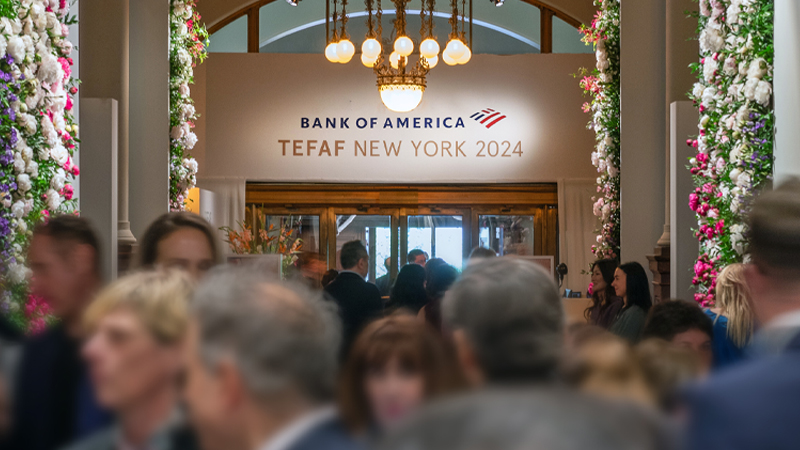
Art and your estate plan
Careful planning could help you achieve your wealth transfer goals without giving up the collections you adore.
Of all possessions, fine art may be among the most personally meaningful, an expression of its owner’s values and sense of beauty. Yet art is also an important financial asset that should be carefully managed with your overall financial goals in mind, says Rosemary Ringwald, Head of Art Planning in the Planning Center of Excellence at Bank of America Private Bank.
That’s especially true when it comes to estate planning. For those with valuable collections, common goals such as distributing wealth to loved ones as tax-efficiently as possible may conflict with another desire: continuing to enjoy the artworks they love. Here, Ringwald discusses some of the challenges and options to help ensure your art satisfies all of your priorities.
What are some of the main challenges of transferring art to beneficiaries?
If you see your art as a legacy that will live on in the family aſter you’re gone, discuss your plans with beneficiaries to be sure they share your passion. If they do, the main challenge is moving pieces out of your estate and into their possession as tax-efficiently as possible. Holding on to the art until your death could trigger sizable taxes on your estate — especially with the giſt and estate tax exemption of $13.61 million per individual in 2024 and $13.99 million in 2025 ($27.22 million in 2024 and $27.98 million in 2025 for a couple) scheduled to drop by about half in 2026.1
Selling or giſting the art to your beneficiaries now might help prevent that problem, but then you’ve lost the main purpose of collecting — the daily pleasure of experiencing your art. One solution may be leasebacks, which enable collectors to give up ownership while maintaining possession.

Rosemary Ringwald, Head of Art Planning in the Planning Center of Excellence at Bank of America Private Bank.
How do leasebacks work?
As the term implies, with a sale leaseback, you sell an artwork to your child or another party, and then make regular lease payments in return for the right to continue displaying the piece on a wall of your home. The art is out of your estate, and the lease payments provide steady income to your beneficiary — income that doesn’t count as a giſt for tax purposes. It’s taxable income for the beneficiary, however, and you’ll owe capital gains tax if the art has appreciated in value since you purchased it. Another advantage: If you believe the art will appreciate further, your beneficiary can purchase the piece at today’s fair market value and own something that will have potentially far greater value later.
But keep in mind that selling the art down the road could also expose your beneficiary to sizable capital gains taxes. In fact, for all their advantages, sale leasebacks (and a related approach known as giſt leasebacks) are complex procedures with trade-offs and risks. So it’s vital to plan carefully and consult with experts before making any decisions.
What risks should collectors be aware of with leasebacks?
One of the biggest involves valuation. For both sales or giſts with leasebacks, the sales price or giſt tax value and the lease payments must be pegged to fair market value. That can be a challenging figure to determine in a subjective and always changing art world. If the IRS decides that your fair market value is incorrect, it could invalidate part or all of the sale or giſt and leaseback transaction. For example, if the lease payments are too high, you have made an additional giſt. If you pay too little, you have a retained interest that may be includable in your estate at death. Consequently, it is preferable to overvalue both the fair market value of the underlying artwork and the lease payments rather than risking estate inclusion with undervaluations. While a collector can request and pay for a Statement of Value from the IRS on artwork appraised at a value of $50,000 or more (this becomes binding on the IRS when issued) there is no such option to have the IRS establish the rental or lease value of the art.
Giſt leasebacks, which involve leasing art that you’ve giſted rather than sold, contain more valuation pitfalls. If the value of the art exceeds your giſt tax exemption amount, you’ll pay 40% of the excess in giſt tax. Additionally, if the IRS determines that the value of the art giſted or the lease payments following the giſt are less than fair market value, the entire artwork may be included in your estate. For most people, a sale leaseback is the better approach because the value paid for the artwork can be excluded from your estate even if the lease payments you have made are less than fair market value. Either way, you should have items valued by a qualified appraiser, such as a leading art auction house, and document every step.
How can trusts help with leasebacks?
With a conventional sale leaseback, the art collector pays capital gains tax on the sale and purchasers pay income tax on lease payments. Conducting a leaseback from an intentionally defective grantor trust (IDGT) avoids the capital gains tax, and the grantor (the art collector) can pay the income tax that would otherwise be paid by a loved one. Trusts can also help collectors solve a common problem of fair and equal inheritance among heirs. Because the value of different artworks, even by the same artist, may vary widely, one beneficiary could wind up with a significantly larger inheritance (and, in the case of a leaseback, higher regular lease payments from the art collector) than another. Instead, you could conduct the sale leaseback through a limited liability company (LLC) held within a trust.
In that scenario, the LLC owns the artworks within a trust for your heirs, so they’re out of your estate. And, if your heirs hold equal shares in the trust, the trustee ensures the heirs receive equal lease payments and equal amounts of the proceeds if the artworks are sold. Another benefit of using the trust for the leaseback is the opportunity to select a trustee who is independent of the art collector and the trust beneficiaries; this way, the lease agreement won’t be treated as a related-party negotiation subject to additional scrutiny by the IRS.
What are some other ways art ownership intersects with estate planning?
If your family isn’t interested in maintaining the legacy, your collection nevertheless remains a key part of estate planning. You may wish to sell the works at some point to support beneficiaries in different ways. Or, if they’re already well provided for, art may help satisfy your philanthropic goals. As with giſts to family, if you plan to donate art to a museum, be sure to speak with its leaders first to gauge their interest. If a particular piece isn’t a good fit for the museum’s collection, the museum might keep it in storage or even sell it. Knowing that in advance lets you make other plans.
When should these discussions begin?
Ideally, planning starts when you start collecting. Buying art is a passionate pursuit. People fall in love with collecting and oſten just start making purchases without thinking about how those transactions may affect their financial and estate plans. But the financial issues of art ownership are complex, and the sooner you start thinking about what you want to happen to your collection during and aſter your lifetime, the more likely you may be to achieve your goals for yourself and your family.
How can Bank of America help you?
The Art Services team at Bank of America Private Bank can walk you through these and other considerations, introduce you to appraisers and help you better understand how art and finance intersect. We can help with everything from estate planning and philanthropy to borrowing against your collection to provide liquidity for other financial goals. Whatever your specific goals are for your collection, Bank of America has the expertise to help you protect your legacy and unlock the potential of your collection.
If you're already a collector or thinking of starting a collection, ask a member of your client team about ways to ensure that your valuable art aligns with your wealth transfer goals.



